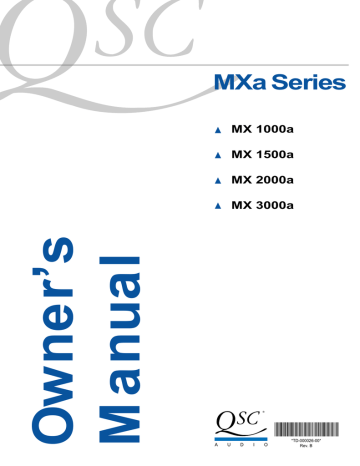LONG-TERM OUTPUT POWER. QSC MX 1500a, MX3000a, MX2000a, MX 1000a, MXa series amplifiers, MX-1000a
Add to my manuals
advertisement

VI. LONG-TERM OUTPUT
POWER
In a properly designed sound system, you can usually obtain the desired sound level without using the full output power of the amplifier; if the “CLIP” indicators flash once in a while, that is perfectly normal.
If the amplifier is operated at extremely high power levels, it may overheat or may even damage the speakers. The amount of stress on the amplifier depends largely on the load and how hard the amplifier drives it. In general, the lower the load impedance, the more stressful the load is.
8-Ohm Loads
The amplifier can operate at practically any power level without risk of overheating. However, if it is pushed hard enough to continually light the “CLIP” indicator, the amplifier’s average output power can reach 250 to 800 watts (depending on the model), which is more than many speakers can handle.
4-Ohm Loads
If the “CLIP” indicator flashes occasionally, the amplifier is approaching its maximum long-term power capacity. If it is lit about half the time, the amplifier channel will probably go into thermal protection within a few minutes.
2-Ohm Loads
Except for an occasional flash, keep the “CLIP” indicator dark to avoid overheating the amplifier channel.
AC CURRENT CONSUMPTION
A major objective in the design of the MXa Series amplifiers—even the highest-powered models—is to permit their operation from readily available, standard
AC power sources. The MX 3000a can deliver 1600 watts per channel into 2-ohm loads—a total of 3200 watts—yet its rated current draw under “normal conditions” is less than 12 amperes at 120 volts AC, which is 1440 watts.
How is this possible? First, “normal conditions” in power amplifier rating means operation, using pink noise as a source, at an average power level equal to one-eighth of maximum power. This is recognized by most of the world’s safety agencies as the loudest you can play music through an amplifier and still keep the incidence of clipping to a reasonable minimum. An amplifier’s peak current draw at full output power into 2 ohms is several times what the “normal” draw is, but its various protection circuits will prevent this condition’s lasting more than a minute or two.
When you plan the AC power hookups for your amplifiers, use Table 2 to predict the current requirements per amplifier. You can use the one-eighth power figures to predict the normal continuous current draw, then add a safety margin to allow for occasional crescendos.
Table 2: Current requirements, in amperes, at 120 VAC under various conditions (divide by 2 for 220–240 VAC operation):
MODEL
MX 1000a
MX 1500a
MX 2000a
MX 3000a
Load
8+8
4+4
2+2
8+8
4+4
2+2
8+8
4+4
2+2
8+8
4+4
2+2
Output power
275 x 2
400 x 2
500 x 2
400 x 2
600 x 2
750 x 2
475 x 2
725 x 2
1000 x 2
850 x 2
1300 x 2
1600 x 2
AC Current
@ Full power
10
15
22
AC Current
@ 1/3 power
5.5
7.5
10
14
21
29
16
25
38
25
40
58
16
31
42
7
11
13
9.5
15
21
AC Current
@ 1/8 power
3
4
5
AC Current
@ Idle
1
1
1
4
5.5
6.5
5
7.5
11
9.5
15
20
1
1
1
1
1
1
1
1
1
11
advertisement
* Your assessment is very important for improving the workof artificial intelligence, which forms the content of this project
Related manuals
advertisement
Table of contents
- 3 WARNING NOTICES
- 3 Speaker Damage
- 3 Speaker Output Shock Hazard
- 3 Rack Mounting Precaution
- 4 OVERALL DESCRIPTION
- 5 INPUTS
- 5 MX 1000a
- 5 MX 1500a
- 5 MX 2000a
- 5 MX 3000a
- 6 OUTPUTS
- 6 Controls and Displays
- 6 AC Power
- 6 OPERATIONS
- 7 Troubleshooting
- 8 Specifications
- 9 Level One
- 10 Parallel, Stereo, or Bridged Operation
- 10 Instructions for Bridged Operation
- 11 LONG-TERM OUTPUT POWER
- 11 AC Current Consumption
- 12 Heat Emissions
- 12 Protection Circuits
- 13 WARRANTY AND DISCLAIMERS
- 13 Disclaimer
- 13 Product Warranty
- 13 VIII. TECHNICAL ASSISTANCE AND SERVICE
- 13 Technical Assistance
- 13 Factory Service
- 14 Qualified Service Centers
- 14 International Servicing
- 14 QSC ONLINE
- 15 INFORMATION